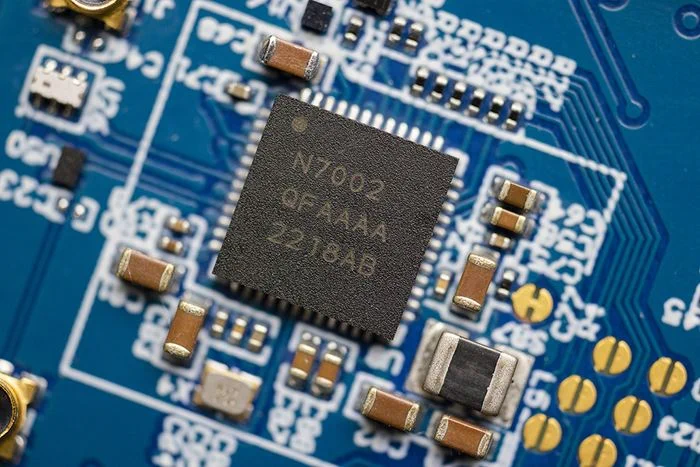Wi-Fi 6 certified solution
nRF7002 DK
The nRF7002 DK has obtained the Wi-Fi 6 certification
 The nRF7002 DK is one of the very few certified embedded reference designs in the market, supporting dual-band and Target Wake Time. This streamlines the process of delivering Wi-Fi 6 certified products based on our nRF70 Series devices. By integrating the nRF7002, customers can leverage our proven technology for consistent performance and enhanced user experience.
The nRF7002 DK is one of the very few certified embedded reference designs in the market, supporting dual-band and Target Wake Time. This streamlines the process of delivering Wi-Fi 6 certified products based on our nRF70 Series devices. By integrating the nRF7002, customers can leverage our proven technology for consistent performance and enhanced user experience.
Obtaining Wi-Fi certification can be complex; with the nRF7002, we simplify the process for our customers, eliminating roadblocks and saving valuable time and resources.
To learn more, you can see the Wi-Fi certification of our nRF7002 DK (WFA125658) and click the link below to read our white paper on Wi-Fi Certification
Low-Power Wi-Fi
Introduction Webinar
Introduction to low power Wi-Fi
Easy integration
Nordic’s low-power Wi-Fi solution allows you to add Wi-Fi connectivity to your Bluetooth LE or cellular IoT application. Take advantage of secure Bluetooth LE-based commissioning for a Wi-Fi device or use the powerful combination of our nRF Cloud with an nRF9160 cellular SiP and nRF7002 Wi-Fi companion IC for Asset tracking.
To use Nordic’s Wi-Fi solution in an application that already uses Nordic's Bluetooth LE solution, these are the overall, simplified steps to follow:
- Implement your Application Host SoC, SiP or MCU.
- Add a Wi-Fi driver and Supplicant
- Use SPI or quad SPI for communication to your nRF7002
- Use a highly configurable COEX interface to ensure best-in-class coexistence
We provide extensive documentation, development hardware, development tools, application samples as well as technical support in DevZone to support your project.
Overall – adding Wi-Fi connectivity to an existing Bluetooth LE application, Nordic’s Wi-Fi solution would require a moderate amount of development work and programming but offer the ability to expand the application’s functionality by adding additional connectivity.
The nRF52840, nRF5340 and nRF54L15 multiprotocol SoCs, nRF91 Series low-power cellular IoT SiPs, and the nRF Cloud are excellent additions to our Wi-Fi solution. Other non-Nordic host devices can also be used.
Applications
While Wi-Fi 6 is well-suited for a wide range of applications, it is particularly beneficial for those that require fast, reliable, and high-capacity wireless connectivity. Some specific applications that are particularly suitable for Wi-Fi 6 include:
 |
High-bandwidth applicationsApplications that require high-bandwidth connections, such as streaming video or transferring large files, can benefit from the faster speeds Wi-Fi offers. |
|||
 |
Applications with many devicesWi-Fi 6 is designed to support more devices on a single network, making it well-suited for applications with a high density of devices, such as public hotspots or large offices. |
|||
 |
Applications with demanding requirementsApplications that require fast and reliable wireless connectivity, such as online gaming or real-time video conferencing, can benefit from the improved performance of Wi-Fi 6. |
|||
 |
Smart home applicationsSmart home devices, such as smart thermostats, security cameras, and lighting systems, can benefit from the improved range and coverage of Wi-Fi 6, as well as the ability to support more devices on a single network and IP-based communication. |
Seamless coexistence
The nRF70 Series companion ICs provide seamless Wi-Fi connectivity alongside our existing products.
It is an excellent addition to the nRF52840 and nRF5340 multiprotocol SoCs. In conjunction with our nRF91 Series cellular IoT SiPs and nRFCloud services, the nRF70 Series Wi-Fi Companion ICs enable Wi-Fi-based locationing (SSID sniffing of local Wi-Fi hubs)
The nRF70 Series ICs can also be used in conjunction with non-Nordic host devices. Our nRF70-linux-driver can be found on the NordicPlayground GitHub.
-
Wi-Fi and Matter
The Matter standard (formerly known as Project CHIP) is an open, interoperable standard for smart home devices that aims to make it easier for customers to set up, control, and use connected devices in their homes. One way that Wi-Fi connectivity relates to the Matter standard is that many smart home devices that are compatible with the Matter standard use Wi-Fi to connect to the Internet and exchange data with other devices and cloud-based services.
For example, a smart thermostat compatible with the Matter standard might use Wi-Fi to connect to the Internet and exchange data with a cloud-based service that provides weather information, energy usage data, or other data types. This data could improve the thermostat’s performance or provide additional features and functionality to the user.
Overall, Wi-Fi connectivity is an essential aspect of the Matter standard, as it provides the connection that enables smart home devices to communicate with each other and with cloud-based services, enabling customers to control and automate their homes in new ways.
Read more about Matter -
Wi-Fi and Bluetooth Low Energy
Several IoT devices can use both Bluetooth LE and Wi-Fi connectivity, allowing them to connect to the Internet and exchange data with other devices and cloud-based services. For example, a smartwatch that uses Bluetooth LE to connect to a smartphone might also include Wi-Fi connectivity to connect to the Internet and access additional features and functionality.
Overall, while Wi-Fi and Bluetooth LE are distinct technologies that serve different purposes, they can be used together in a variety of ways to provide connectivity and communication for a wide range of devices and applications. -
Wi-Fi and cellular IoT
Our nRF91 and nRF70 Series devices excel when used in conjunction for asset-tracking applications. The nRF9160 SiP enables cell-based and GNSS/GPS-based locationing. Many asset tracking applications include an extra Wi-Fi IC for SSID-based Wi-Fi locationing. The nRF70 Series is the perfect choice for this use case. We have sample applications for our nRF9160 SiP as a host and support for integration in our Cloud Location Services on nRF Cloud.
Wi-Fi locationing bridges the gap between cell based locationing and GNSS. Less power hungry than GPS/GNSS and more accurate Wi-Fi is an ideal addition to most locationing systems. Especially in areas where there is bad GPS reception, like in city centers or Inside buildings.
Learn more
Wi-Fi’s increasingly important role in the smart home

Wi-Fi 6 has made the popular wireless technology better suited to the IoT, forming a key part of the Matter standard and making it a foundation of the smart home.
Learn more
How, when and why did Nordic start developing Wi-Fi solutions?

Nordic says Wi-Fi has long been the “number one” missing capability requested by its customers and this was the perfect opportunity to merge into its global organization a world-class Wi-Fi development team with a proven track record of delivering state-of-the-art Wi-Fi solutions. It also means Nordic will be one of the few companies to offer all three of the world’s most popular wireless IoT technologies: Bluetooth, Wi-Fi, and cellular IoT.
Learn more
What's next for Wi-Fi 6?

Wi-Fi 6 has brought significant enhancements to IoT applications, but the Wi-Fi Alliance is already working ahead.
Such is the pace of global advance that any technology that stands still will spiral down into obscurity. The same is true of wireless standards. Each time a revision to Bluetooth, Matter, Thread, Wi-Fi, or another standard is adopted, you can be sure that engineers have already worked hard for months or even years on the next upgrade.
Learn more
Wi-Fi 6 brings battery-powered IoT to Wi-Fi

Wi-Fi connectivity is an obvious choice for IoT developers, particularly given its pervasiveness in the home and many consumer, business, and industrial environments. It's even widely available on airplanes.